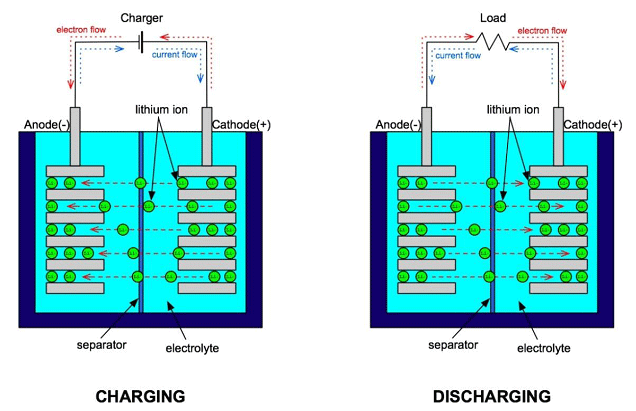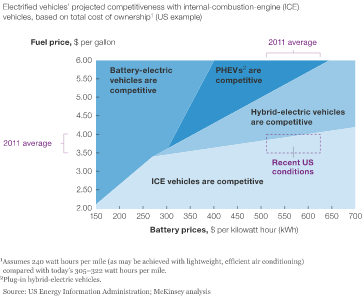 SolidEnergy, yet another company born out of MIT, is making amazing strides in the battery industry that will drastically reduce the cost of electric vehicles (EVs). SolidEnergy’s core innovation is a re-imagining of the electrode within lithium-ion batteries (the battery used in everything from cell phones to EVs). This improvement, “can increase the amount of energy that lithium-ion batteries store by 30 percent or more.”1 In terms of costs, the main measurement is the cost per kilowatt-hour (kWh). If EVs are to stand a chance against internal combustion vehicles, or the new hydrogen powered vehicles – with a range of more than 300 miles – the cost of batteries must come down dramatically.
SolidEnergy, yet another company born out of MIT, is making amazing strides in the battery industry that will drastically reduce the cost of electric vehicles (EVs). SolidEnergy’s core innovation is a re-imagining of the electrode within lithium-ion batteries (the battery used in everything from cell phones to EVs). This improvement, “can increase the amount of energy that lithium-ion batteries store by 30 percent or more.”1 In terms of costs, the main measurement is the cost per kilowatt-hour (kWh). If EVs are to stand a chance against internal combustion vehicles, or the new hydrogen powered vehicles – with a range of more than 300 miles – the cost of batteries must come down dramatically.
In a 2012 research, McKinsey & Company concluded that the average cost per kWh of lithium-ion batteries used in EVs sat between $500 and $600.2 As the chart to the right displays, at this cost per kWh the cost of owning EVs is only competitive with the cost of owning traditional internal combustion vehicles when fuel prices are between $3.50 and $4.00 per gallon. Competitive, not cheaper, only competitive. This is a huge barrier to EV adoption. Why would someone pay more to own an EV, that in just about every case (aside from all Tesla models) has a range of less than 100 miles?3
While the actual costs of EV battery packs are closely guarded, different sources offer prices anywhere from $18,000 to $8,000.4 This is a major factor, if not the main factor, in the price of the current stable of EVs. Kirk Kardashian of The New Yorker offers and excellent, concise explanation of the battery problem for EV manufacturers:
The underlying problem with electric vehicles is the cost and ineffectiveness of their batteries. In a Nissan Leaf, for instance, the lithium-ion battery accounts for more than eight thousand dollars of the sticker price, about twenty-eight thousand dollars, and the vehicle can travel only seventy-five miles before it needs to be charged again.
-Kirk Kardashian,The New Yorker
This is where SolidEnergy comes in. The companies argues that its improvements to various components of the lithium-ion battery, “could be used to make battery packs that cost $130 per kilowatt-hour.”5 How do they do it?
To understand exactly how SolidEnergy improves the lithium-ion battery, a rough idea of how the battery works is needed. To that end, David Biello of Scientific American offers an excellent introduction to the functions of a lithium-ion battery:
A plastic film separates a positive and negative electrode, all of which is bathed in electrolyte, in this case a clear chemical solvent. The electrolyte is a carbonate liquid that carries the lithium ions. Each of these lithium ions acts as a shuttle of sorts, carrying an electron from the cathode to the anode. At the cathode, the lithium ions are absorbed, freeing up those electrons to act as current and ionizing the lithium. To recharge the cell, simply add electricity, which drives the lithium back out of the cathode and into the anode, and it’s ready to do it all over again.
– David Biello, Scientific American

SolidEnergy has made improvements to the electrode (anode and cathode) and the electrolyte used in lithium-ion batteries. SolidEnergy replaces the graphite electrodes, used in the current batteries, with a more efficient lithium-metal construction. As noted by Kevin Bullis, this has been done before, but it often led to the electrodes short-circuiting and, in many cases, causing fires, or to prevent short-circuiting the practice requires replacing the electrolytes with solid polymer electrolyte which drastically reduce the battery’s performance.6 SolidEnergy uses a novel 2-part electrolyte approach to the short-circuiting problem. The company coats their lithium-metal electrodes with an incredibly thin polymer and also incorporates a liquid electrolyte; it should be noted that the liquid electrolyte is a ionic liquid, meaning it is not flammable.7
SolidEnergy is clearly on the brink of revolutionizing the battery industry, and the awards and honors are beginning to pile up:
- SolidEnergy won the first MIT accelerate contest in 2012
- The company won the top prize in the “Deployment and Infrastructure” category in MIT’s Clean Energy Competition.
- They took 4th place in Rice Universities 2012 Business Plan Competition
- Awarded a The Massachusetts Clean Energy Center Grant of $40,0008
Whats even more, SolidEnergy announced, in October 2013, that they have joined in a strategic partnership with A123 Venture Technologies, a branch of A123 Systems – one of the largest lithium-ion battery manufacturers.9 While success is not guaranteed, it seems clear that as SolidEnergy and A123 grow together, EVs still stand a chance against gas and hydrogen vehicles.
- Kevin Bullis, MIT Technology Review “A Trick for Making Batteries Safer Could Also Make EVs Affordable,” November 21, 2013. ▲
- Russell Hensley, John Newman, and Matt Rogers, McKinsey Quarterly, “Battery technology charges ahead,” July 2012. ▲
- CleanTechnica did a good feature/specs rundown of all the EVs available for purchase today. The rundown is also available in a public Google Docs Spreadsheet ▲
- AutoBlog, The New Yorker, an MIT Technology Review to name a few. ▲
- Kevin Bullis, MIT Technology Review “A Trick for Making Batteries Safer Could Also Make EVs Affordable” November 21, 2013. ▲
- Kevin Bullis, MIT Technology Review “A Trick for Making Batteries Safer Could Also Make EVs Affordable” November 21, 2013. ▲
- Ibid ▲
- MIT Accelerate Contest; MIT Clean Energy Competition; Rice University Business Plan Competition; Mass Clean Energy Center Grants ▲
- Strategic partnership press release; A123 Systems. ▲


